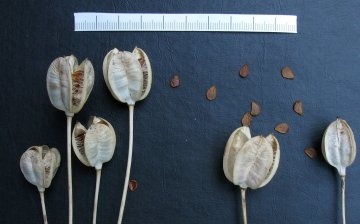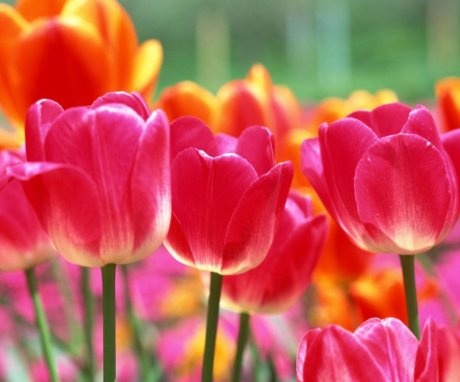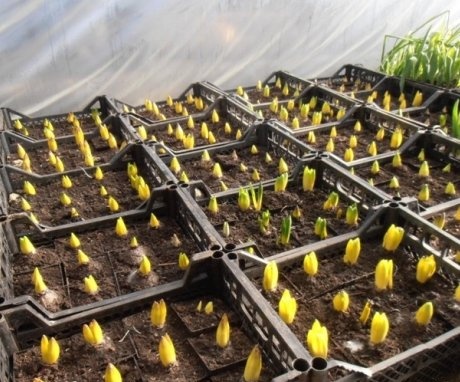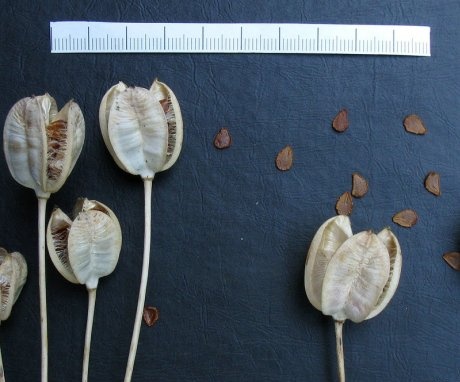A step-by-step guide to growing tulips from seed at home
One of the first flowers to delight with bright colors in early spring is the tulip. The plant is simple in agricultural technology, it will not be difficult to grow it on a personal plot. There are two ways to propagate a crop: bulbs and seeds. The article describes the cultivation of tulips from seeds, the rules for collecting planting material, planting and further care.
Methods for growing tulips from seeds
Planting flowers with bulbs is considered the easiest way to propagate. But with this option, it will not be possible to get an unusual flower with an original color. Therefore, some growers are engaged in the selection of new varieties as a hobby.
You can grow tulips using seeds in open and protected ground.
In the open field
The beds are formed by the usual method, flush with the topography of the ground and on a hill (with sides). For the winter period, the seeds must be removed from the soil so that they do not die under the influence of low temperatures. In the spring, the forming bulbs return to the nursery again.
In the greenhouse
This option is preferable for regions with severe winters. The shelter provides protection against freezing of tubers. This method has the main advantage - it does not take 3 years to dig out the forming bulbs.
Regardless of where the garden is equipped, care for the forming bulbs is necessary. You can't call it complicated, but some nuances still exist.
Preparatory stage
One of the important and crucial stages of planting tulip seeds is the preparation of the soil, planting material and containers.
Seed preparation
Sowing is usually done in September-October. Seeds need to be carefully examined, select only whole plates with a transparent layer along the edges. If deformations, holes or spots characteristic of rot are noticed, they are rejected.
Preparation of containers, soil
Seeds are planted in soil or containers. As a container you can use:
- flower pots;
- garden boxes;
- plastic bowls or bowls;
- pallet with stable legs.
The garden also needs to be prepared:
- knock down the sides from the boards;
- dilute loamy soil with sand, enrich with humus;
- fill the frame of the bed with soil mixture.
The finished bed should be watered with salted water. After that, the soil is loosened to prevent the formation of lumps.
Reference! In a high bed, the seeds are more likely to survive in the winter. In addition, it is easier to construct insulation on it.
Bulb formation
If planting in the fall was carried out in compliance with all the rules, then with the onset of spring, small single leaves will sprout from the soil, outwardly resembling the feathers of green onions. By summer, the leaves will dry out, and an onion with a diameter of only 2 mm will form at the root. You don't need to dig it out at this stage.
The main task for the grower is to provide moderate moisture and top dressing. You also need to remove weeds in a timely manner, it can drown out tender young seedlings, from which they will die.
If the sowing was carried out in fertile soil, then the fertilizers applied in the fall in the form of humus should be enough for the flowers for the season. It is better to feed depleted soil with additional potassium and nitrogen.
Three seasons pass before the bulb grows in size to 2-3 cm. At this stage, she gives 1-2 baby bulbs. Flowering still hasn't come yet. In mid-summer, the bulbs should be dug up and stored in a dry place until fall. To detect small children, it is recommended to remove a 12 cm layer of soil and sift it through a sieve. Bulbs are planted in open ground or in a greenhouse in mid-October.
The bulb reaches maturity by 5-6 years, when beautiful large flowers appear on the stem.
How to plant tulip seeds correctly
On the prepared soil, grooved beds are formed. Their depth is 15 cm. Sand is poured onto the bottom of the excavation, on which a dense layer of seeds is poured. The surface is covered with soil no more than 1-2 cm thick. The remaining depression (about 2 cm) is again covered with sand.
Reference! The germination rate of tulip seeds is not very high, so they are generously introduced into the groove.
If the winters in the region of growing flowers are harsh, you need to insulate the beds during the cold weather. This can be done using a film. Humus is also suitable as a heat-insulating layer (a layer of 5-7 cm is formed).
Further care
When growing tulips from seeds, attention is paid to:
- irrigation (do not excessively moisten the soil, sprouting roots can rot);
- temperature regime (containers are kept indoors at a temperature of 5-12 °);
- weeding
- loosening the soil.
- Garden beds in open ground or in a greenhouse should be covered with a layer of peat or dry leaves (branches).
Important! If the pots are kept on a glazed balcony, it is necessary to build a shelter for the winter so that the forming onion does not freeze. With the onset of March, the insulation is removed, watering is restored.
It is recommended to use complex formulations as fertilizers. Nutrient dressings are introduced together with irrigation water.
Possible problems
Like all bulbous crops, tulips are susceptible to disease. In total, there are about 30 diseases, but in real life their predominant number is rare. Of the fungal infections, the most dangerous are:
- gray rot;
- white (sclerocial) rot;
- fusarium (wet rot);
- typhulosis;
- penicillosis.
Viral diseases can cause no less harm:
- variegation;
- necrotic spotting (August disease).
Growing tulips from seeds is a rather lengthy process. The first flowering occurs after 5-7 years. It's a shame if a young plant dies from insects, which are also capable of destroying breeding specimens. Among the most dangerous pests:
- root onion mite;
- onion hoverfly;
- purple scoop;
- bear;
- wireworm.
To prevent the development of diseases and the invasion of parasites, it is recommended to follow simple rules:
- when choosing a place for a garden bed, give preference to remote sites from cabbage and potatoes;
- the soil should be loose, enriched with nutrients;
- when sowing, planting density and depth are taken into account;
- before planting work, disinfecting measures should be carried out;
- it is necessary to store the planting material under favorable conditions (temperature, humidity);
- if diseased plants are detected in the beds, they must be removed in a timely manner in order to prevent the spread of infection.
Features of growing tulips from seeds at home
To get a certain type of flower, you need to provide artificial pollination. For this, the parent plants are selected, which are planned to be crossed. It is easier to complete the task if both plants bloom in the same period. If the time interval between flowering is long enough, the pollen collected from one tulip is stored in a paper towel in the refrigerator. The pistil is pollinated twice with an interval of 2-3 days.
After the seed pod turns brown, you need to start collecting the seed.Otherwise, it will simply fall to the ground. Dried workpieces must be stored at a temperature of 5 to 8 degrees above zero.
Sowing begins in the fall, regardless of the location chosen. If there is no summer cottage, you can grow flowers at home. The main thing is to create the optimal temperature at each stage of bulb development, to ensure timely moisture.
Plan a landing needed for September-October. Containers or pots with a depth of 25-35 cm are used as containers. Expanded clay or perlite is poured onto the bottom to arrange drainage. The soil is suitable lightweight, supplemented with clay and peat. You can fill containers with universal soil, which is sold in any flower shop. Before the onset of winter, the soil is moderately moistened. Even less moisture is required during the resting period of the plant. With the onset of spring, the irrigation regime is restored.
In nature
Representatives of the Liliaceae family that grow in the wild reproduce mainly by seed. In almost all wild varieties, the capsule bursts after drying, after which the seeds fall out on the ground. One contains up to 250 pieces. The germination rate of volunteers is low due to the fact that most of it ends up on the surface of the soil. Seed material quickly deteriorates under the influence of sun and rain.
How to collect seeds from ready-made tulips
No special knowledge is required to collect tulip seeds. The main criterion for selecting a flower is the presence of a beautiful and large inflorescence with a stalk. From a weak plant, good shoots will not work.
After tulips bloom in the garden, you need to designate large specimens with wide petals. After the end of the flowering period, time is given to dry the stalk. At this time, the seeds take on a reddish or purple hue, which means they are fully formed.
Important! The petals of a faded tulip quickly wither and turn yellow. Sepals and receptacles lose their elasticity, which leads to inflorescence inflorescence. If it is not secured with sticks or fishing line, the seeds will fall out of the cotyledon to the ground.
The time for collecting the seeds is right after the stalk has dried. This is done carefully using a wooden stick and a gauze pad. The darkened seed is deposited on it. Under natural conditions, the boxes are dried until they burst. It is not worth freeing small grains from the houses, in them seeds are better preserved until disembarkation.
Seed tulips from China
The Chinese trading platforms offer seeds of many varieties of tulips. The specimen pictures are impressive in the assortment of flower sizes and colors. However, after studying user reviews, it turns out that the seed quality of many sellers leaves much to be desired. Although there are successful examples of growing flowers from seeds, unfortunately there are few of them.
If you want to show your talents in tulip breeding, you need to pay attention to well-known producers. Among them are Polish agricultural firms that adhere to high quality standards.
Tips from experienced florists
The advice of experienced florists will help to avoid many mistakes when growing tulips from seeds.
- Regardless of where the garden bed is set up in the open field or in the greenhouse, it is necessary to make a nursery with an elevation above the ground. It is filled with soil mixed with humus. It is not recommended to use fresh manure or bird droppings.
- Before sowing, the seeds are placed in a refrigerator, placing them on damp filter paper. This procedure promotes rapid germination.
- After distributing the seeds over the soil, you need to cover them with earth (up to 2 cm). It is not necessary to press down and thicken the ground cover. With deep planting, you can not wait for seedlings.
- When buying seeds, preference should be given to well-known companies. Large operators of the agricultural market pay great attention to the quality of their products.
To gain your own experience, you need to grow 3-4 varieties of tulips, using seeds. Based on the advice of other gardeners and, taking into account your mistakes, you can grow from the category of selection lovers into an entrepreneur. With low costs, the business will become profitable in a few years.
Watch a video about preparing tulip seeds for growing:















I have never grown tulips from seeds, mainly using bulbs that I brought in different species from my friends and neighbors. I think I still need to try, since I have few tulips.